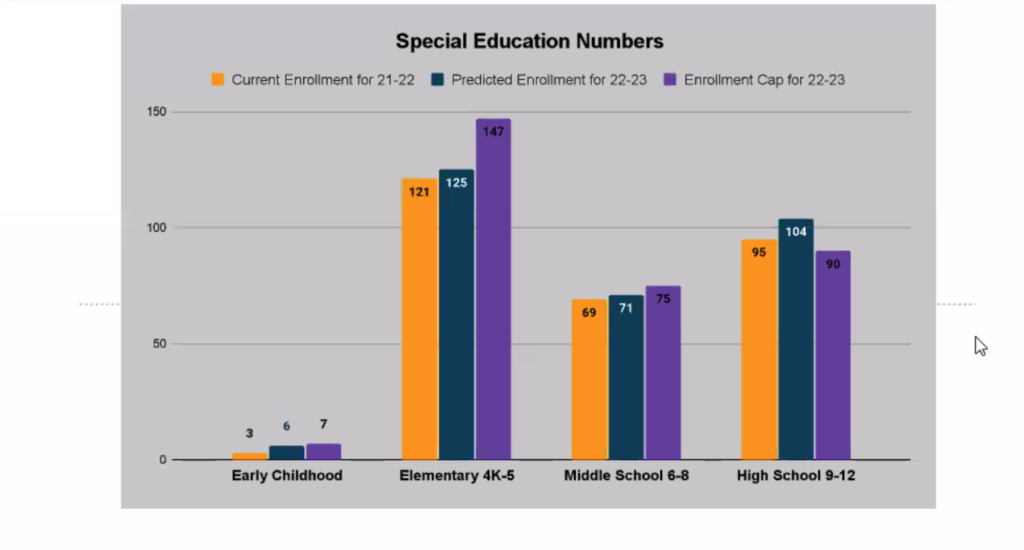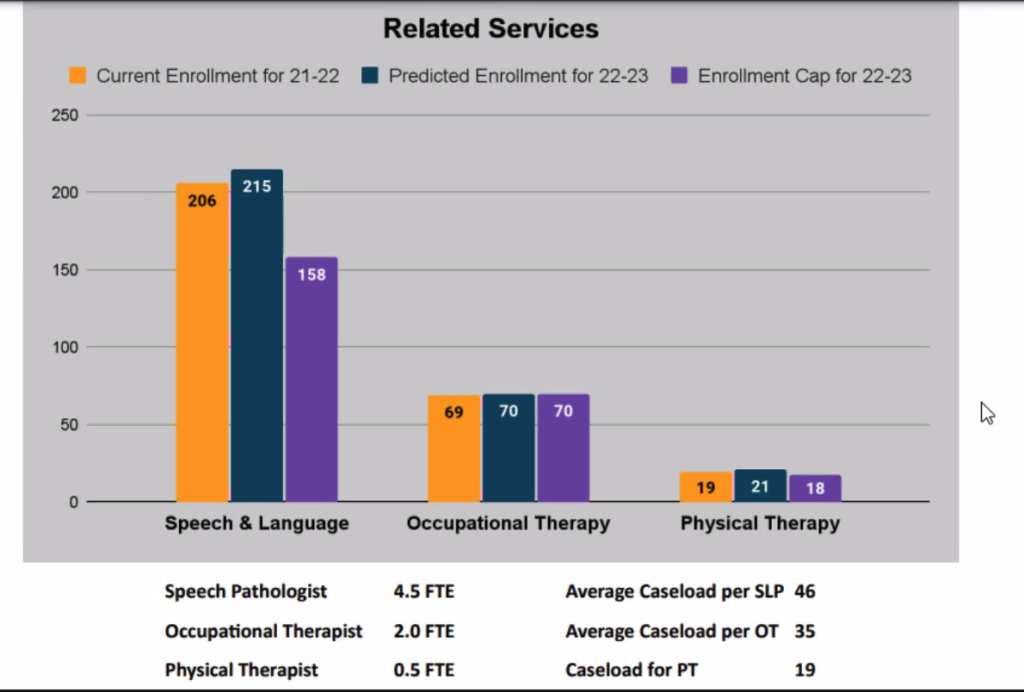By Kim McDarison
Members of the Whitewater Unified School District Board of Education Monday approved special education open enrollment space limitations for the 2022-23 school year.
Space limitations were not set for general education students looking to open enroll into the district.
Numbers presented to the board included maximum space within each special education category available to a total number of students, including resident students, enrolling into the district.
Space limitations were developed based on the district’s ability to supply special education services using its current level of staffing, Director of Pupil Services Lanora Heim said.
Available space for students in need of special education services were capped for the 2022-23 school year as follows:
Cross Categorical Special Education: early childhood, 7 students; grades 4K-5, 147 students; grades 6-8, 75 students, and grades 9-12, 90 students.
In addition, limitations of “no additional students” were set for supports such as deaf and hard of hearing services, including audiology, and services for the visually impaired, based on a lack of staffing. The district contracts such services from an outside source, Heim noted during the meeting.
Students in need of speech and language services are limited to 158, those in need of occupational therapy services are limited to 70, and those in need of physical therapy are limited to 18.
Students with needs
Aided by slides, Heim shared open enrollment statistics as they related to several categories within the scope of special education.
According to Heim, assessing space available for open enrollment students within the district is done annually as required by state statute.
Pointing to a bar graph labeled: “Number of Students with Special Needs as of Jan. 3, 2022,” Heim noted that, within a category of “speech and language” the district currently supports 206 students. Next school year, she said, she anticipates the district will be looking at potentially supporting 215 students. She recommended an enrollment cap for the 2022-23 school year of 158 students.
In the category of “occupational therapy,” Heim said the district is currently supporting 69 students, and anticipates a potential enrollment of 70 students next school year. She recommended capping enrollment at 70 students for the 2022-23 school year.
In the category of “physical therapy,” Heim said the district is currently supporting 19 students, with an anticipated enrollment for next year of 21 students. She recommended capping enrollment for students in need of physical therapy at 18 students.
Pointing to a bar graph labeled: “Special Education Numbers,” Heim presented numbers of students receiving special education services grouped by grade level.
According to the graph, this school year, the district is supporting three students enrolled in an early childhood program. Next school year, the number is anticipated to climb to six. Heim recommended that the district cap enrollment into the early childhood program in the 2022-23 school year at seven students.
This school year, in grades 4K-5, the district is supporting 121 students with Individual Education Programs also known as IEPs. That number was predicted to increase in the 2022-23 school year to 125 students, Heim said. She recommended capping enrollment next school year at 147 students.
Looking at numbers in the middle school, Heim said the district currently supports 69 students with IEPs. Next year, the number is anticipated to increase to 71. She recommended capping enrollments for next school year at 75 students.
At the high school level, the district is currently supporting 95 students with IEPs. The number is predicted to increase next school year to 104 students. Heim recommended capping enrollments at 90 students.
Planning for special needs
According to Heim, space limitations apply to students entering the district through the state’s open enrollment program.
“If they move to our district, they’re ours; no matter what, we serve them,” Heim said.
Students who have previously enrolled in the district through open enrollment stay with the district.
“We never turn anyone away who has been accepted in,” she said.
Heim cited a limited number of district staff as the main driver behind a need to set space limitations. Costs, too, affected decision-making, she said. As an example, she pointed to services contracted through outside sources by the district, such as those used to support the deaf and hard of hearing, and services for the visually impaired.
“We don’t actually have our own employees; we contract them through CESA 2, so that would be an additional cost,” she said.
Heim said recommendations she was bringing before the board were designed to identify space that could be made available to open enrollment students without creating a need for more staff.
Enrollment predictions were made, in part, by comparing the number of high school seniors using special education services that would be leaving the district with the number of 3-year-old students preparing to enter the district, Heim said.
“We look at the open enrollment application to see who actually comes in; we physically look at our numbers and see if we have space and we can take that child in without needing to hire additional staff. And so most of the time we are able to do that and sometimes we are not able to do that when we look at the limits,” Heim noted.
While state statutes require predictions to be made in January, she said, more reliable numbers are available in September.
“Our actual numbers will be in September because we have a huge amount of transfer-ins and transfer-outs, and a huge amount of special ed IEPs, so right now, I’m just making a guess with actual students that I actually know.”
Looking at the ratios between staff and students, Heim said, the district has 206 students who are supported by four full-time and one part-time speech pathologists.
“That’s an average of 46 kids per teacher,” she said.
Sixty-nine students in need of occupational therapy are supported by two full-time therapists, and the district has a part-time physical therapist who is currently supporting 19 Whitewater students. She is shared as an employee with the East Troy school district, Heim noted.
Responding to questions asked by board members, Heim said Walworth, Rock and Jefferson counties have Birth-to-3 programs. When students in those programs are 120 days away from their third birthday, the school district is notified.
Currently, she said, she is aware of 20 children enrolled within Birth-to-3 programming that will soon be nearing their third birthday.
Some of those children will require speech-related services and others will require “a lot more services,” she said.
“So we know about them 120 days before they turn and then we actually evaluate them 90 days before they turn 3, and we start services on their third birthday,” Heim said.
At the 4K level, students are screened to determine if speech or other services are required, she added.
Responding to a question about monetary aids and costs associated with special education students, Heim said when a student open enrolls into a district from another district, the district receiving the student also receives $12,500, but, she said, some of those students could have needs that cost in excess of $100,000.
Heim said most of Whitewater’s neighboring school districts have adopted open enrollment limitations.
“There are very few in our area that are wide open for open enrollment. Right now, I know Elkhorn and Edgerton are, nobody else is wide open, they all have space limitations,” she said.
Responding to questions about Medicare reimbursement for special needs services, Heim said the district works to maximize the Medicare billing piece for students that qualify.
Responding to questions about diverting funds from supplies to support hiring another teacher, Heim said teachers within the district working with special education students have a budget for supplies of about $750 each. If she took all the money for supplies to fund more staff, she might be able to hire a part-time person, she said.

The above bar chart as presented by Whitewater Unified School District Director of Pupil Services Lanora Heim shows the number of students enrolled in special education by grade level within the district. The orange bars represent students currently enrolled. The blue bars represent students anticipated to enroll next school year. The purple bars represent the enrollment caps which were approved Monday for the 2022-23 school year.

The above bar chart as presented by Whitewater Unified School District Director of Pupil Services Lanora Heim shows the number of students using related special education services, including speech and language, occupational therapy and physical therapy. The orange bars represent students currently enrolled. The blue bars represent students anticipated to enroll next school year and the purple bars represent the enrollment caps which were approved Monday for the 2022-23 school year. Information below the graph notes the number of employees the district has to perform each service and each individual’s associated average caseload.
This post has already been read 1220 times!
